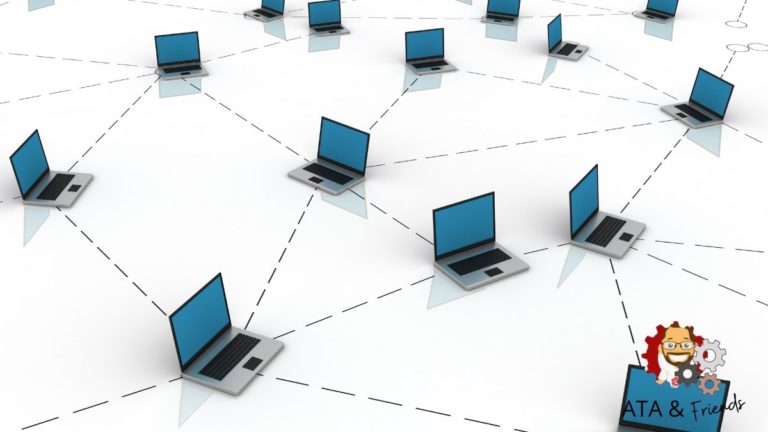Do you access remote computers regularly? If you look after multiple servers, keeping track of remote connections gets challenging as the number of your managed servers grows. Using a remote desktop connection manager can help you take back control of your remote desktops.
In this article, you will learn about five remote desktop connection managers to consider using. Rest assured that the remote desktop managers that you’ll read about here are free! There are no trials and without limit to the number of managed remote machines.
This post is kindly sponsored by Devolutions. Devolutions is dedicated to providing universal password and access management solutions to organizations worldwide – bringing productivity and security together.
For more information on Remote Desktop Manager, please visit https://devolutions.net/remote-desktop-manager/
Disclaimer: All ATA-sponsored posts are 100% independent. Sponsors have no say-so in the writing of these posts.
Devolutions Remote Desktop Manager
Let’s first start this roundup by covering an excellent remote desktop connection manager called Remote Desktop Manager (RDM) from Devolutions. Devolutions offers two editions of RDM – free and enterprise (paid). This article will only cover the free edition.
We’ve found that RDM has the most features through our research and trial testing compared to the other remote desktop connection managers in this article. Moreover, even the free edition comes with features that may overwhelm first-time users.
RDM supports many popular connections, including but not limited to Microsoft Remote Desktop (RDP), SSH, Apple Remote Desktop (ARD), TeamViewer, VNC, Telnet, and Citrix. RDM has more supported connections that are too many to list here.
Installation
Should you want to try out RDM, you can install it using the EXE or MSI package on your computer or via the portable ZIP version. Depending on which installer option you choose (refer to the screenshot below), you’ll download a minimum of 185MB installer size as of version 2020.3.29.0.
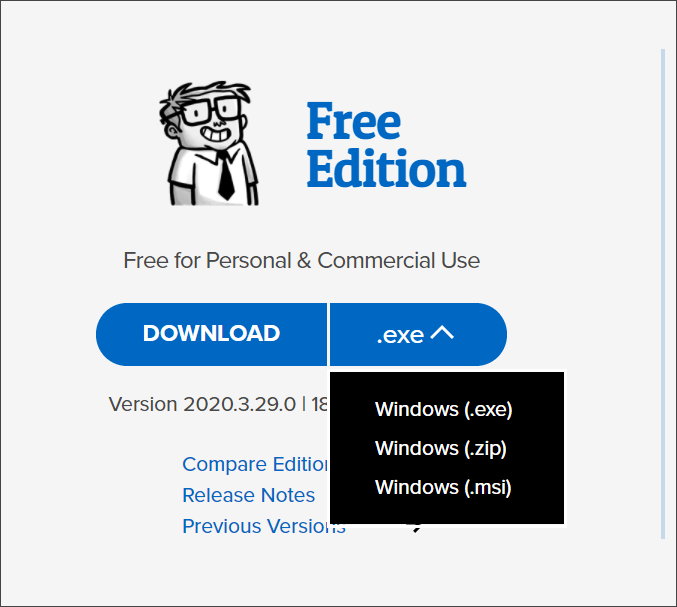
Data Source
Every remote desktop manager needs some repository to save data like remote hosts, credentials, or configuration. In RDM, data repositories are called data sources. Data sources serve as the container of all the entries in RDM.
By default, RDM uses an SQLite instance as the data source. However, there are other data source types you can use. Do you want your data source to reside in your cloud storage? Then, you can choose Google Drive and Dropbox among the data source options in RDM.
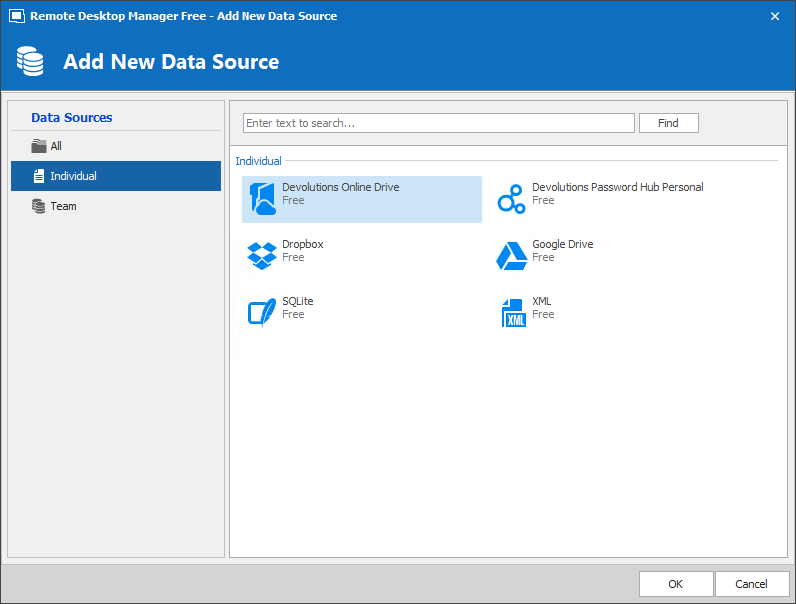
Not all data sources have the same capabilities. Visit the RDM Data Source Types page to learn more about the different data sources.
Backup and Restore Remote Desktop Connections
We all know that bad things happen, and the possibility of data loss is always there. Luckily, Devolutions offers a free online backup feature with RDM. The Online Backup automatically backs up the data from your data source to the Devolutions cloud.
Devolutions claims that the Online Data is encrypted using a client key, therefore it is impossible for Devolutions to access your information.
If you register a free Devolutions account, you can use the online backup feature in RDM. Then, you’ll only need to configure a backup name in RDM, which automatically activates the online backup.

After enabling the online backup, RDM automatically backs up all data in your data source 30 seconds after making any modifications, such as adding or removing sessions. You should enable the online backup to all your data sources if you have more than one.
When needed, you can restore online backups to the current or new data source. You can find the list of online backups in File > Backups > Restore. Then, you can select which online backup to restore.
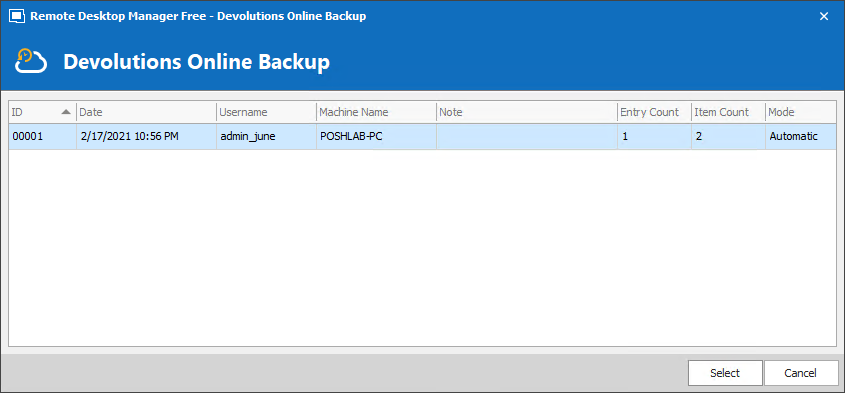
With the flexibility to choose different data sources, coupled with the online backup feature, you’ll never have to worry about keeping your RDM data protected.
Migrating from Other Remote Desktop Connection Managers
If you decide to try out Devolutions RDM and are already using another remote desktop connection manager, you can import existing connections. For example, RDM supports importing sessions from various tools like those listed below.
- mRemoteNG
- DameWare Mini Remote Control
- RoyalTS
- RDTabs
- TeamViewer Manager
- LogMeIn
- visionApp Remote Desktop
Remote Desktop Connections are called Sessions in Devolutions RDM.
The demo below shows importing remote desktop sessions from a mRemoteNG connection file. As a result, RDM creates new entries for the imported connections.

Remote Desktop Connection Display Modes
Display modes are the different modes or layouts with how you can view your sessions. When opening a remote desktop session in RDM, there are three display modes – Embedded (tabbed), Undocked, and External. The list below briefly explains each display mode.
- Embedded – This display mode embeds the remote desktop sessions in the main RDM window. RDM uses tabs to display sessions, as a result, each session has its own tab. Tabs are also dockable in panes, as you can see in the image below, which can help you view multiple sessions at once.
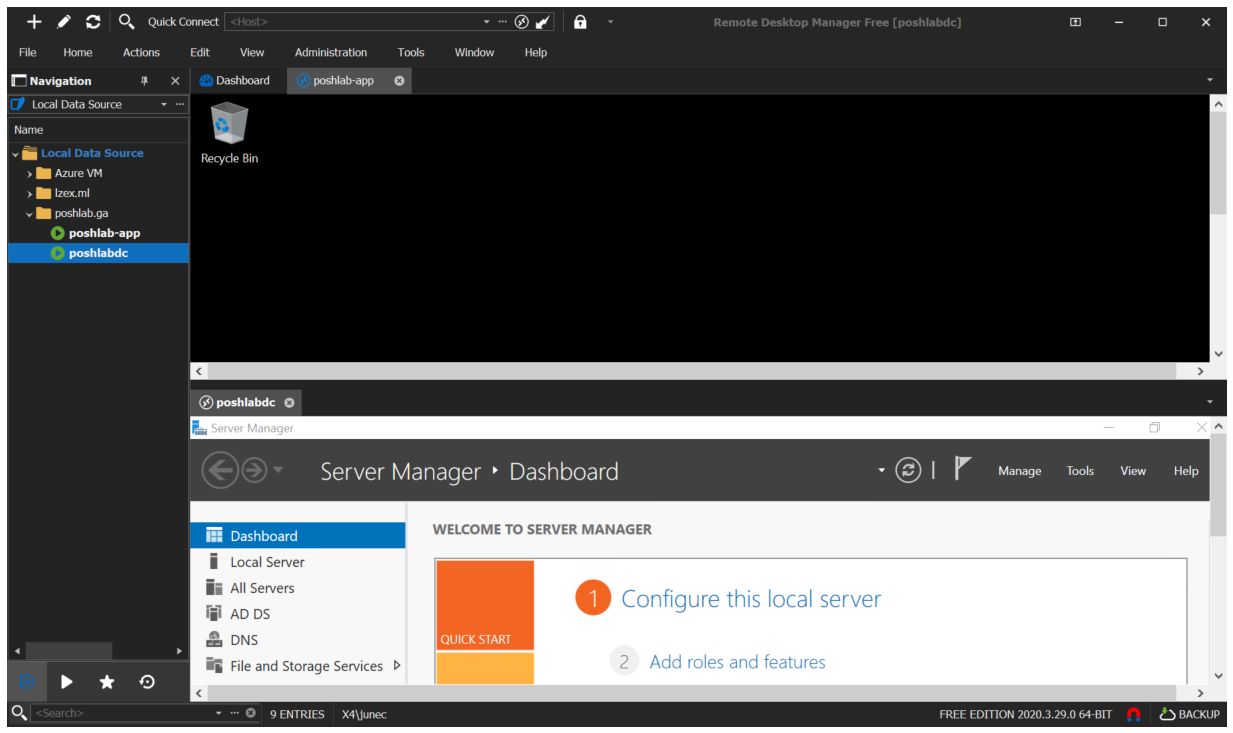
- Undocked – RDM displays remote desktop sessions in undocked windows. As a result, you can view your sessions in multiple separate windows.
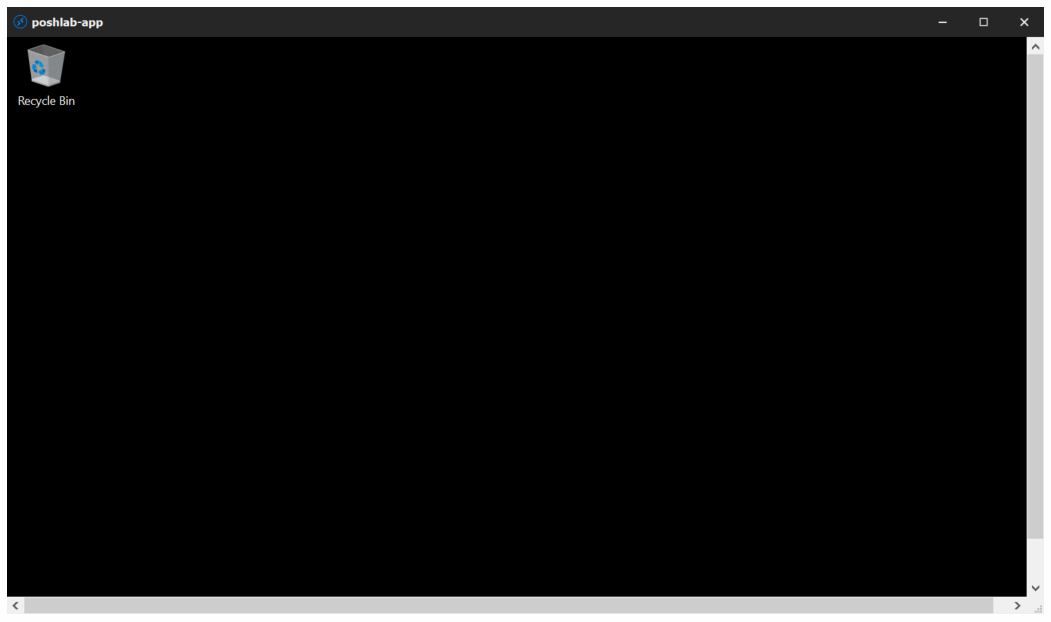
- External – This mode opens remote desktop sessions using the built-in Windows RDP client, mstsc.exe.

Built-In Management Tools
Suppose you need to access information from a remote desktop, such as running services or the registry. RDM has built-in management tools for that, all located inside RDM, making admin tasks more manageable. With a single click, you can do the following actions.
- Create an inventory report.
- List current login sessions.
- Check the remote computer’s uptime.
- Check if the remote computer is online.
- Run a port scan.
- Run a traceroute.
- Perform ping and continuous ping.
- Retrieve remote events.
- Display and access the remote registry.
- Read and manage scheduled tasks.
- Manage installed programs.
- Administer shares.
- List remote printers.
Other Interesting Features
Devolutions RDM is more than just a typical remote desktop manager. Below are some of the other interesting features RDM offers.
Secure Information Manager – save credentials and even personal information as you would in a dedicated password manager. Moreover, the list below shows other information types you can save in RDM.
- Credit Card
- Cryptocurrency Cold Storage
- Secure Note
- Website
- Alarm Codes
- Application Send key
- Bank Account
- Email Account
- Passport
- Safety Deposit
- Wireless Router
- Software License
- Driver’s License
- Social Security Number
- Membership Card
Import Login – import your saved login details from other password managers. Furthermore, the list below shows the third-party password managers RDM supports for importing.
- Aurora Password Manager
- 1Password
- Dashlane
- DataVault
- EnPass
- Google Chrome
- KeePass
- LastPass
- Passpack
- Passportal
- Password Agent
- Roboform
- Password Depot
- SplashID
- Password Safe
- Sticky Passwords
File Repository – save various documents and files into the data source such as the those in the list below.
- Document (any file)
- Html
- Spreadsheet
- Text
- Rich Text
- SSL Certificate
- Data Source Configuration
- Image
- Video
- Phonebook
Web Browser – you can create a website entry optionally including the username and password. You can then open the saved website inside RDM, auto-filling the username and password if present.
However, know that some sites do not support using web browsers embedded in a different application. As a result, the below screenshot shows Google not allowing login saying that the browser might not be secure.
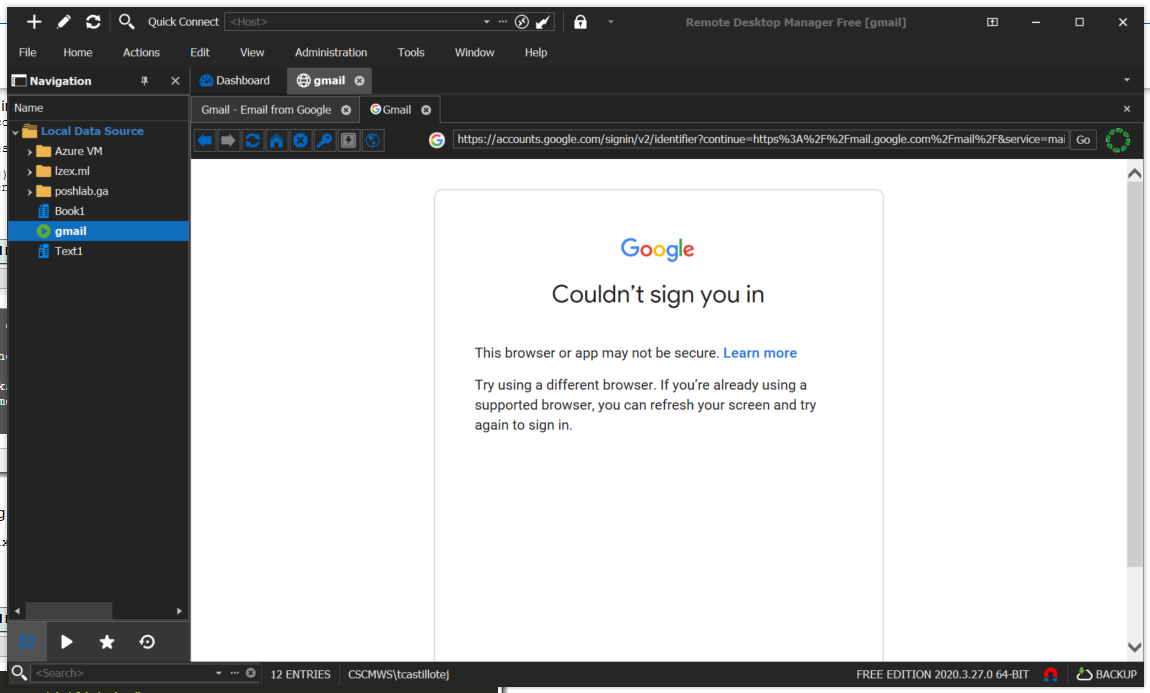
File Editor – built-in editor for Html, Spreadsheet, Rich Text, and Text files. For instance, the screenshot below shows an Excel spreadsheet inside the RDM spreadsheet editor.
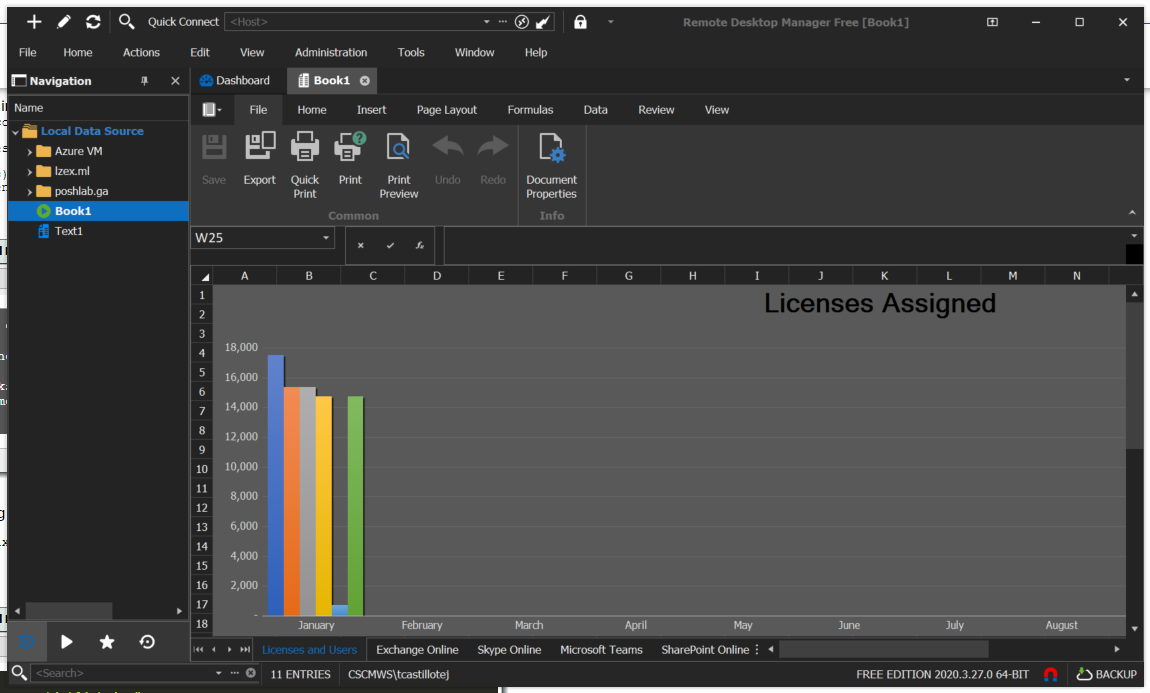
The Devolutions Remote Desktop Manager offers a lot of other features to explore. If you want to learn more, visit the support page, where you can find help documentation, tutorials, and more.
mRemoteNG
Multi-Remote Next Generation or mRemoteNG is an open-source and free remote desktop connections manager. mRemoteNG carries features such as multi-tabbed connections and multi-protocol support. The supported protocols as of version 1.76.20 are:
- RDP (Remote Desktop/Terminal Server)
- VNC (Virtual Network Computing)
- ICA (Citrix Independent Computing Architecture)
- SSH (Secure Shell)
- Telnet (TELecommunication NETwork)
- HTTP/HTTPS (Hypertext Transfer Protocol)
- rlogin
- Raw Socket Connections
Installation
There are two ways to get mRemoteNG; as an MSI installer or a ZIP file. The ZIP file lets you use mRemoteNG as a portable tool because you can save it to a USB drive. Handy if you use different computers. Not only does it make mRemoteNG portable, but the saved connection file(s) are also.
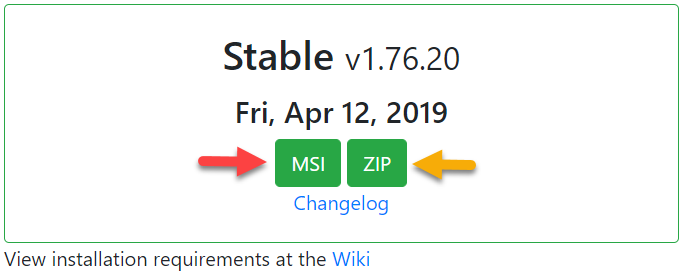
Remote Desktop Connection Management
mRemoteNG lets you create folders which is useful if you want to group remote connections. Putting remote connections in a folder helps you apply the same configuration, including credentials to all remote desktops.
Inheritance is a setting that sets whether the remote connection will inherit all its parent folder’s properties. Inheritance is optional, and its default state is off. You can turn on inheritance on each connection.

Remote Desktop Connection Display Modes
There are only two display options to open remote desktop connections; tabbed and full screen. The screenshot below shows mRemoteNG with opened remote desktop connections in a tabbed view, for instance.
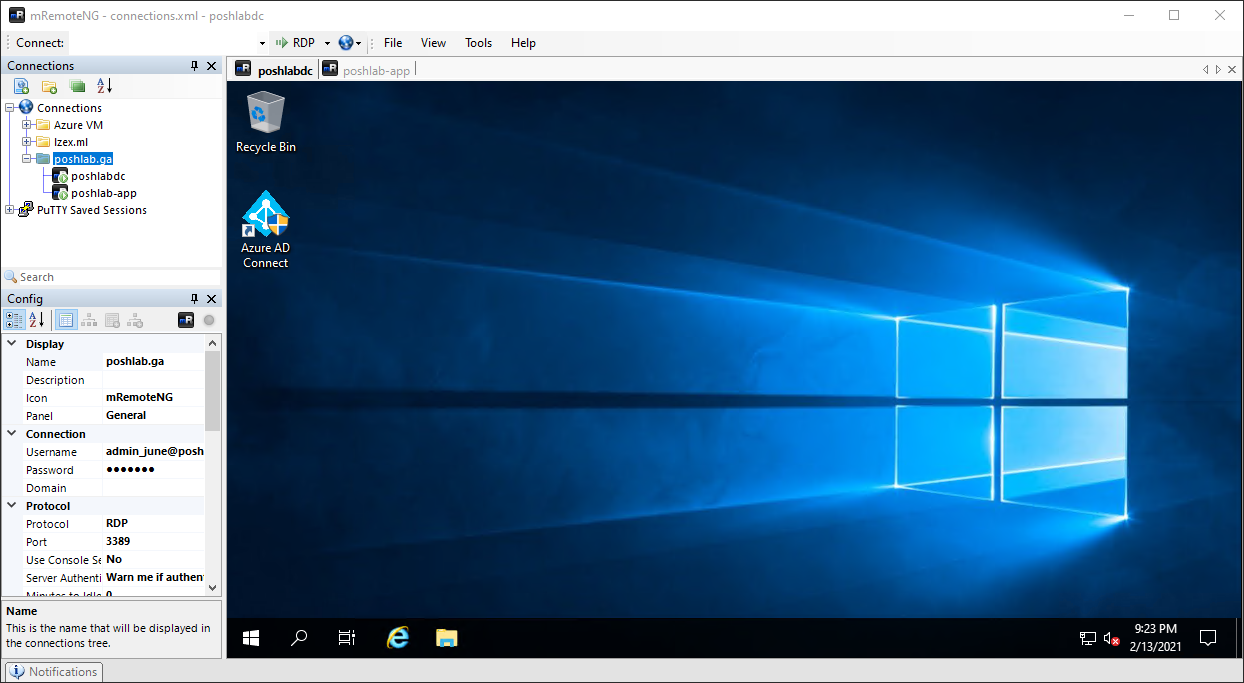
Backing Up Connection Files
mRemoteNG uses a connection file in XML format to store all your remote desktop connections. The connection file is saved in the same folder as the mRemoteNG executable file by default. However, mRemoteNG does not restrict the location where you want to save the connection file.
Meaning, it is possible to save your connection files to a cloud-synced location such as Google Drive or OneDrive. Additionally, mRemoteNG automatically keeps a backup of the connection file after saving every modification.

Other Interesting Features
Here are other interesting and useful features that comes with mRemoteNG.
- SSH File Transfer – Enables transferring files to remote hosts over an encrypted tunnel. Protocols supported are SFTP and SCP. Useful too if your transferring files to a Linux docker container, for example.
- Import Connections from Active Directory – With this feature, you can import computers from the Active Directory (AD). However, this is only applicable to AD-joined computers.
- Screenshot Manager – You can take screenshots of your remote desktop sessions. The screenshot manager allows you to view, copy, save, and delete screenshots within mRemoteNG.
Visit the mRemoteNG documentation to learn more.
RD Tabs
The following remote desktop manager, RD Tabs, claims to be “the original multi-tabbed remote desktop client.” And as the name implies, RD Tabs’ primary feature is multi-tabbed remote desktop connections. But that’s not all.
Installation
To install RD Tabs, you can download the latest version from the Avian Waves RD Tabs download page. As of this writing, the newest version is 3.0.12. Also, there is no portable version for RD Tabs. What you’ll get from the download is an installer file.
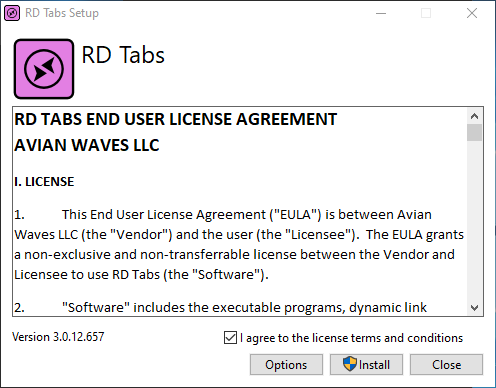
Remote Desktop Connection Management
At first, you may think that RD Tabs is just another GUI frontend for MSTSC. But as soon as you start adding new connections, you’ll realize that RD Tabs is highly customizable remote desktop connection manager.
Looking at the RD Tabs options, there are a lot of customizations to control remote desktop connections. Below are some RD Tabs options.
- Set how many seconds to wait before attempting to reconnect a disconnected session.
- Set the maximum number of reconnect attempts before failing.
- Changing the default tab titles for the different session statuses (connecting, connected, disconnected).
- Enable or disable full native screen resolution for high DPI displays.
The screenshot below is the RD Tab’s default interface, where you can create a new remote connection on the fly, for example.
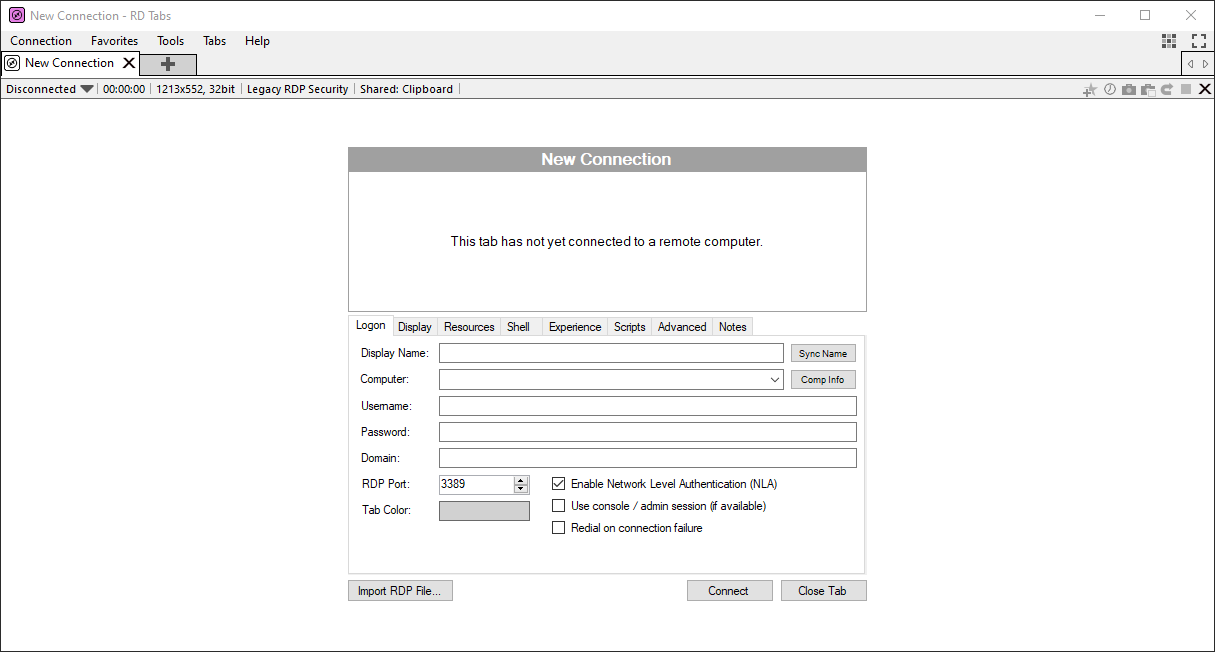
Saved remote desktop connections use a folder tree structure. Remote desktops are called favorites, and groups are called folders. For instance, in the screenshot below, there is one folder named Lab and two remote desktop connections under it.

Remote Desktop Connection Display Modes
There are several viewing modes or layouts to open remote connections, such as multi-tabbed, detached tabs, and multi-pane. For example, the screenshot below shows RD Tabs’s default view, which is multi-tabbed.

In addition, the image below shows RD Tabs’ multi-pane tabbed layout for the admins who prefer to work in a single-window remote desktop.

Remote Desktop Connection Backups
RD Tabs also allows you to export all application settings and saved favorites. This feature helps keep RD Tabs configuration data portable, which also serves as a backup.
To back up connections to a file, press F6 on your keyboard while inside RD Tabs, or click Favorites > Manage Favorites. And on the Manage Favorites window, click Export All to begin exporting all the connections.
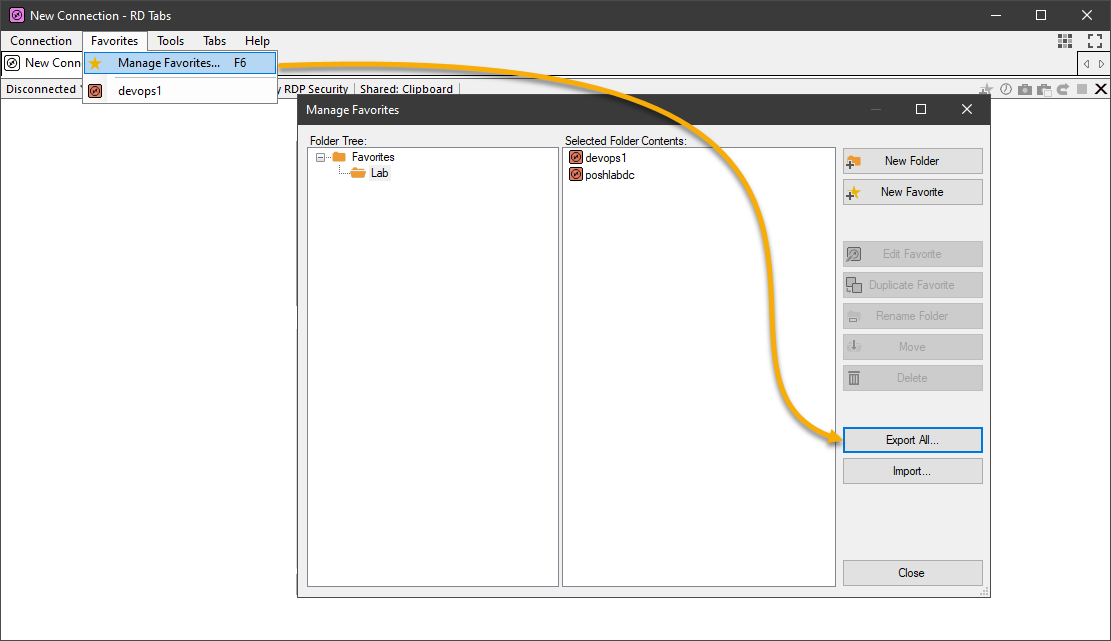
When you want to backup RD Tabs settings to a file, click on Tools > Options or press F3 on your keyboard while inside RD Tabs. On the RD Tabs options window, click on Export.
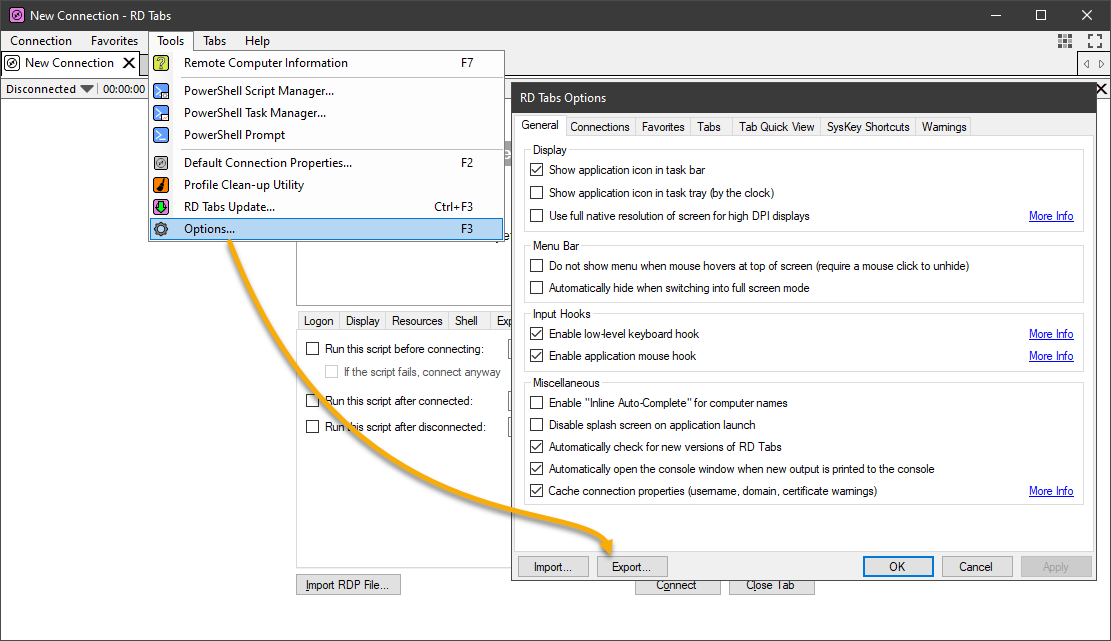
A potential issue that you may encounter is not being able to save passwords. RD Tabs respects the DisablePasswordSaving registry setting in HKLM\SOFTWARE\Policies\Microsoft\Windows NT\Terminal Services. This policy means that you cannot save passwords when adding new remote desktop connections.
Other Interesting Features
- Screen capture tool – Are you taking screenshots to document your remote machines? RD Tabs also has a built-in screen capture tool!
- PowerShell Integration and Scripting – Lets you create, manage, and execute PowerShell scripts. Also allows you to automate parts of RD Tabs functionality.
To know more about RD Tabs, refer to the included help file or the RD Tab official website.
Microsoft Remote Desktop Manager App
It would be irresponsible in an article about remote desktop managers in Windows, not to mention Microsoft’s own app called Remote Desktop.
Installation
You can download the Microsoft Remote Desktop app from the Microsoft Store.
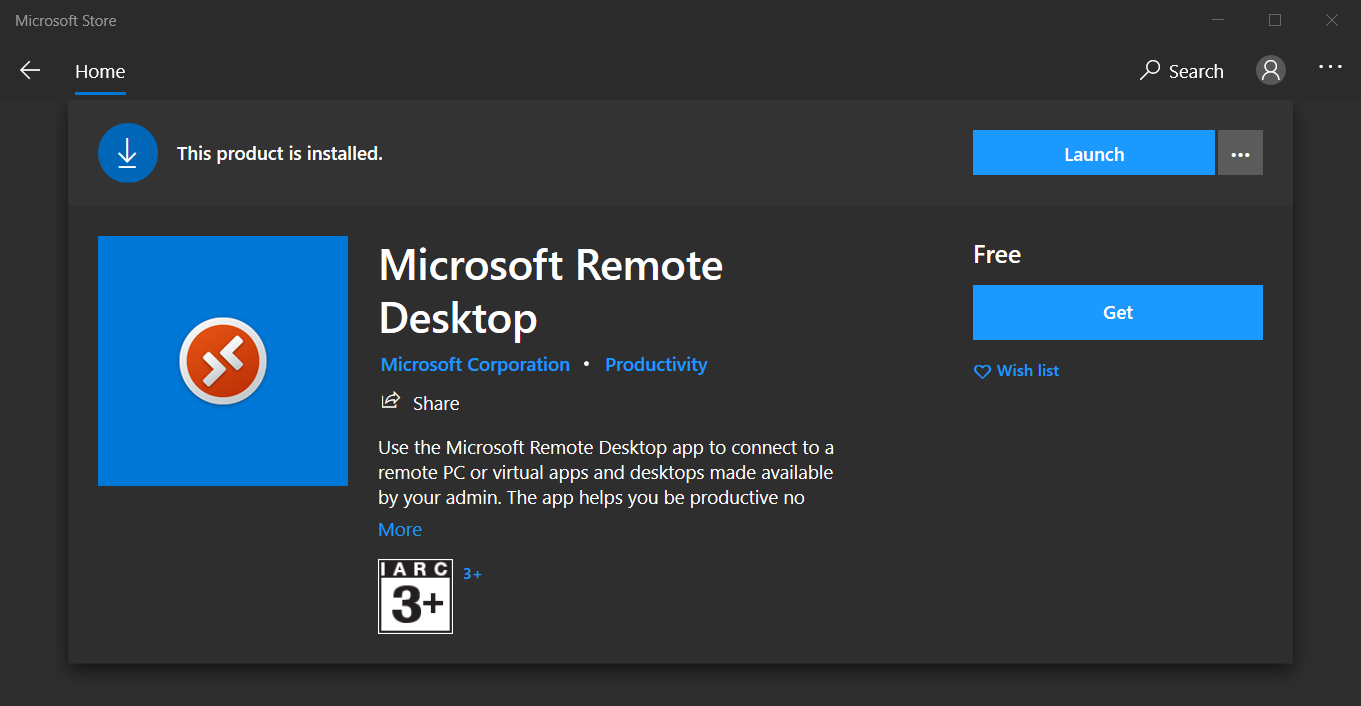
When you launch the Microsoft Remote Desktop app, the first thing that catches your eye is its minimalistic and modern interface, a far cry from its legacy predecessor.

Built-In Credential Management
Remote Desktop has a built-in credential manager, which lets you save multiple credentials. When adding new remote connections, you are allowed to select a saved credential from a dropdown. Choosing from pre-saved credentials helps avoid login errors and account lockouts, as a result.

Remote Desktop Connection Display Modes
When it’s time to open a remote connection, there are two options to display the remote desktop; in the same window as the main user interface or in separate windows.
There’s no real advantage to using the single-window display mode. Because using this option means that you may only view one remote desktop at a time, which can be challenging when managing multiple remote desktop sessions.
For example, the screenshot below shows the single-window remote desktop view in the Microsoft Remote Desktop app.
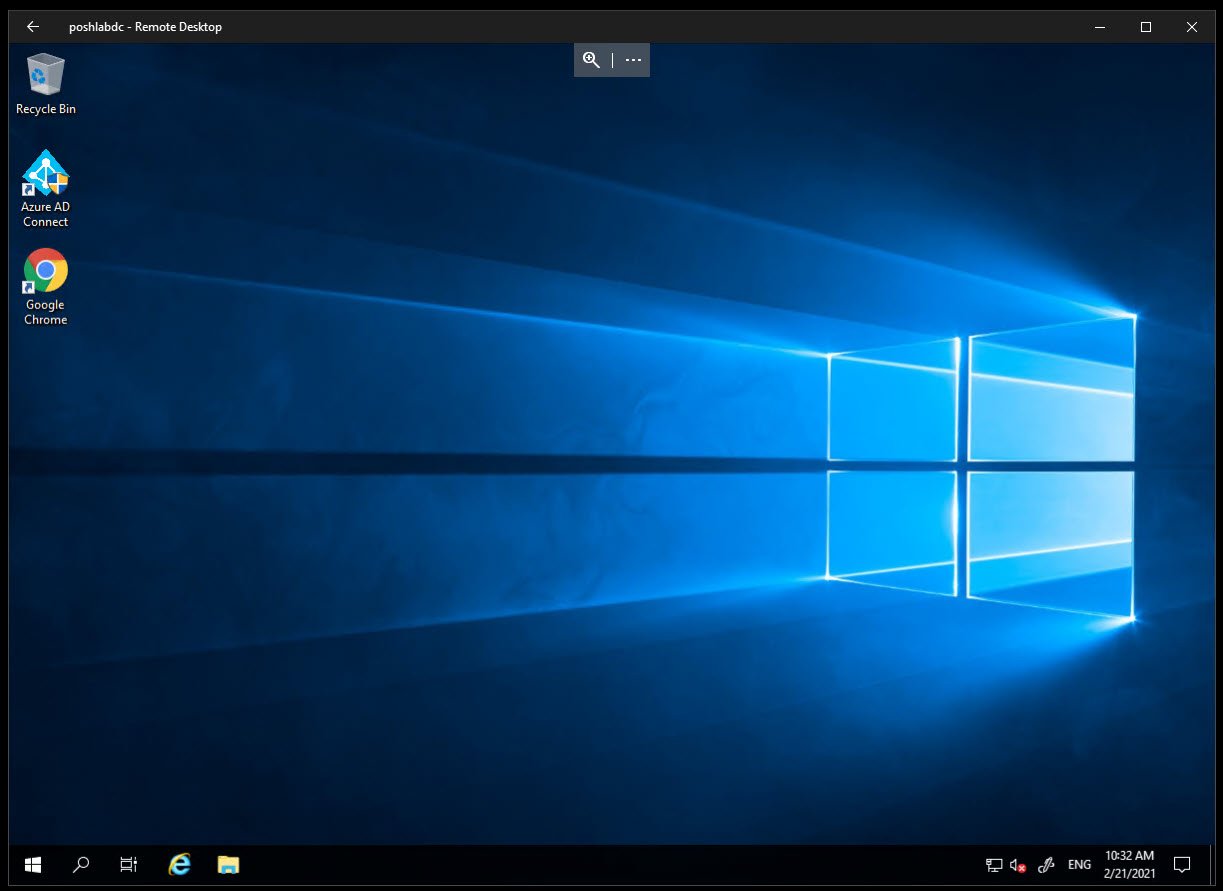
The second option is to open remote desktops in separate windows. Users accustomed to viewing multiple remote desktop windows, like side-by-side, would benefit from this display option. For example, the screenshot below shows the multiple windows remote desktop connections.

Remote Desktop Connection Backups
What’s more, Remote Desktop allows you to backup the remote connections to a file. Meaning, restoring the remote connections from backup is possible, too. The backup and restore feature may come in handy when moving between computers or accidental data deletion.
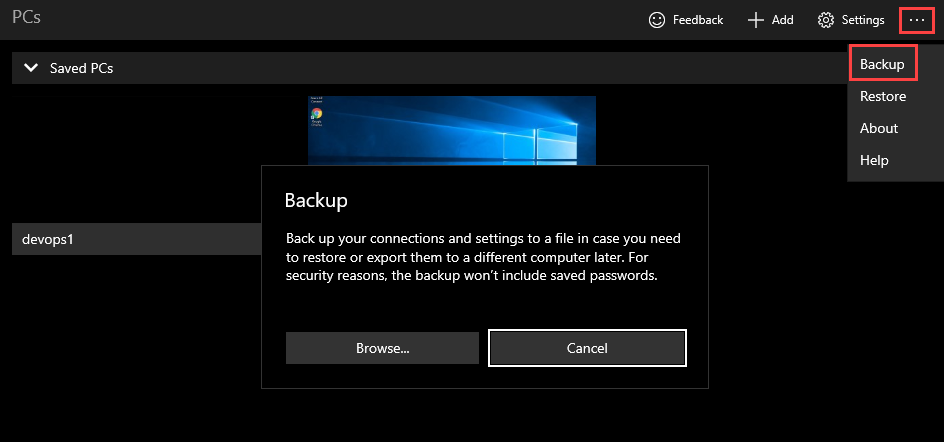
When backing up remote connections to a file, the Remote Desktop app does not include passwords for security. So restoring remote desktop connections from backup will not restore the associated credentials.
Other Interesting Features
Some of the other Remote Desktop app features are:
- Smart screen resizing – It lets you choose whether to stretch the content of the remote desktop or show scroll bars when resizing the Remote Desktop app.
- Keyboard command redirection – Whether to direct keyboard commands to the remote session or the local PC.
- Prevent the screen from timing out – This allows to keep the screen awake while there’s an active session running.
To know more about the Microsoft Remote Desktop app, visit the Get started with the Microsoft Store Client page.
MultiDesk
Another remote desktop connection manager that is compact, portable, and lightweight is MultiDesk. MultiDesk is a tabbed remote desktop manager that acts as a GUI frontend of the built-in Remote Desktop Connection Client (MSTSC).
Installation
There’s no installation required to use MultiDesk. You only need to download the latest MultiDesk zip file. Then, extracted its contents on your computer.
After extracting the zip, open the MultiDesk64.exe or MultiDesk.exe (for 32-bit systems) to launch the remote desktop manager.
Remote Desktop Connection Management
The interface uses a tree view to represent the hierarchy of groups and servers. Admins can set a credential to a group, which each server in the group inherits. The steps to add a new group and set a credential is listed below.
- Right-Click on the node where you want to add the new group.
- From the context menu, click on Add group.
- On the Add group window, enter the Display Name you want to assign to the group.
- Then, enter the username, password, and domain. The port value is 3389 by default.
- When you’re done filling out the details, click on OK to save the group.

The screenshot below shows MultiDesk after adding a group and servers.
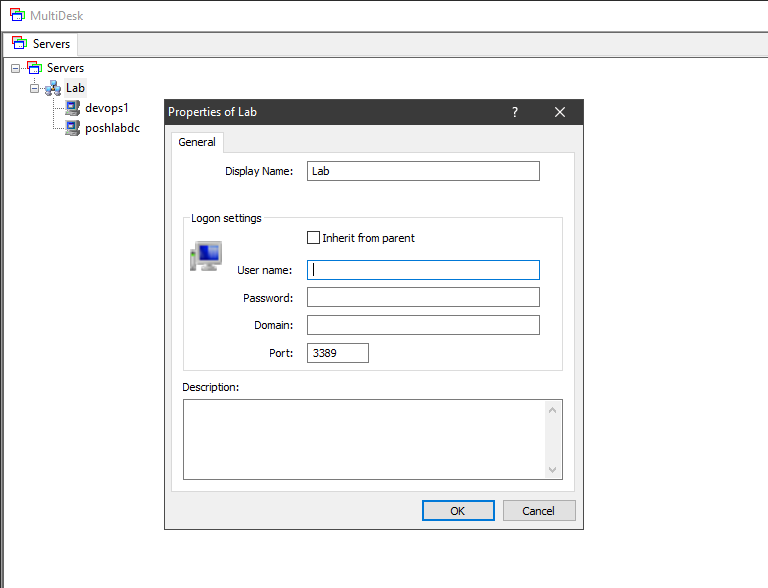
After adding remote connections, there are two ways to open remote desktops; connecting to one remote desktop at a time or connecting to all remote desktops under a group. The screenshot below shows connecting to a group of remote desktops at once.
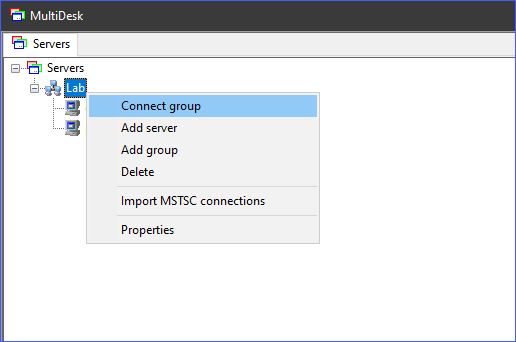
Remote Desktop Connection Display Modes
MultiDesk can display remote desktop connections in two ways; in tabs or full screen. In the tabbed view, the remote desktop connections are shown in separate tabs inside MultiDesk (refer to the screenshot below).
The tabbed display mode makes switching between remote desktop sessions convenient.
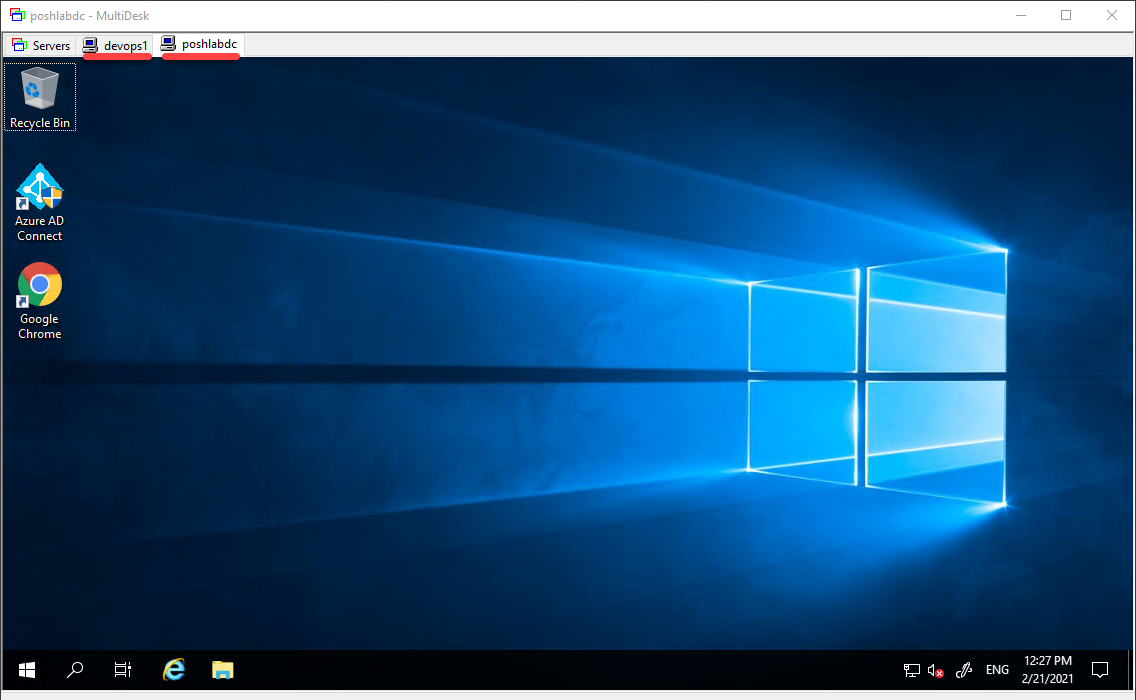
On the other hand, in full-screen mode, the remote desktop session covers the entire computer screen. You’ll need to minimize the current session to get to other remote desktops.
Remote Desktop Connection Backup
One thing lacking from MultiDesk is the ability to export and import connections from the main program. If you are concerned about losing your remote desktop connections, your workaround is to back up the file MultiDesk.xml.
The MultiDesk.xml file is where MultiDesk saves all remote desktop connections. The file is located in the same folder as the MultiDesk program.
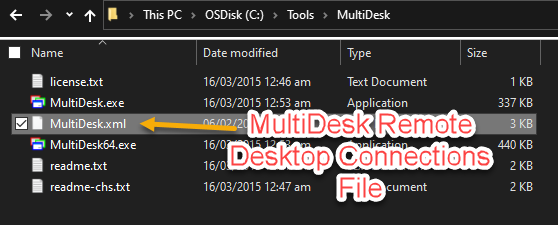
How you back up the connection file is up to you, your options are open. But, one convenient way is to sync the MultiDesk.xml file to cloud storage like Google Drive or OneDrive.
Other Interesting Features
MultiDesk is light on features because it is a tool that is focused on its primary purpose – to manage remote desktop connections.
- Import cached MSTSC connections – If you’ve used MSTSC before to connect to remote desktops, those connections are cached in %LOCALAPPDATA%\Microsoft\Terminal Server Client\Cache. MultiDesk is capable of importing those MSTSC cached connections.
To learn more about MultiDesk, visit the MultiDesk documentation page.
Remote Desktop Connection Managers Side By Side
Let’s wrap up with a summary of all the features of the different remote desktop connection managers this article covered. The table below shows the remote desktop manager features side by side comparison.
| Remote Desktop Managers | Installation | Connection Management | Display Options | Backup | Other Features |
| Devolutions Remote Desktop Manager | MSI / EXE Setup and Portable Zip | Import connections from third-party tools. Built-in credential manager. Group remote desktops. Support for multiple protocols. | Embedded (tabbed and docked), Undocked, and External (MSTSC). | Can use multiple data source types. Backup data to Devolution’s Cloud (Online Backup). Automatic cloud backup. Seamless restore from backup history. | Store secure information such as secure notes, credit cards, and more. Import login from third-party password managers. Store documents and files. Built-in web browser for saved websites. Built-in file editor. |
| mRemoteNG | MSI Setup and Portable Zip | Import connections from RDP and Putty files. Group remote desktops. Supports multiple protocols. | Tabbed and full screen mode. | Can use multiple XML connection files. Automatic connection file backup. | SSH file transfer. Import connections from Active Directory. Built-in screenshot tool and screenshot manager. |
| RD Tabs | EXE Setup | Can import connections from RDP files. Group remote desktops. Supports RDP only. | Tabbed and detached window. | Export and import configuration and favorites from file. | Built-in screen capture tool (copy to clipboard) |
| Microsoft Remote Desktop Manager | Windows 10 Store App | Built-in credential manager. Group remote desktops. Supports RDP only. | Single-window and detached window. | Backup settings and connections to file (excluding passwords) | Smart screen sizing Keyboard command redirection Prevent screen from timing out while a remote desktop session running. |
| MultiDesk | Portable Zip | Group remote desktops. The only supported protocol is RDP. | Tabbed and full screen mode. | Manual backup. | Import cached MSTSC connections. |
Choosing a Remote Desktop Connection Manager
When choosing a remote desktop manager, there’s “no one size fits all.” The sensible action is to consider first your personal, team, or business requirements. More features don’t necessarily mean better or that you need them.
For example, if you only need the basic functionalities, mRemoteNG is an excellent choice. With mRemoteNG, you can quickly get set up and start adding and managing your remote desktop connections.
But, if you require a more centralized remote desktop connection manager, you will benefit more with Devolutions RDM. RDM comes with lots of useful features for a free tool. While some parts may seem like bells and whistles, it’s good to know that those features are there if you’ll need them.
